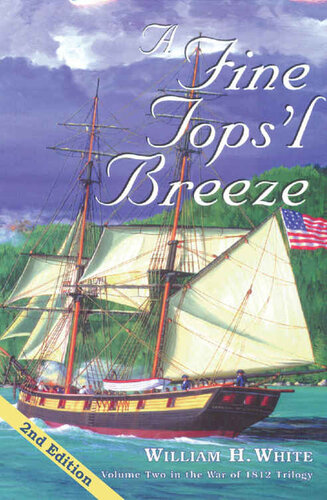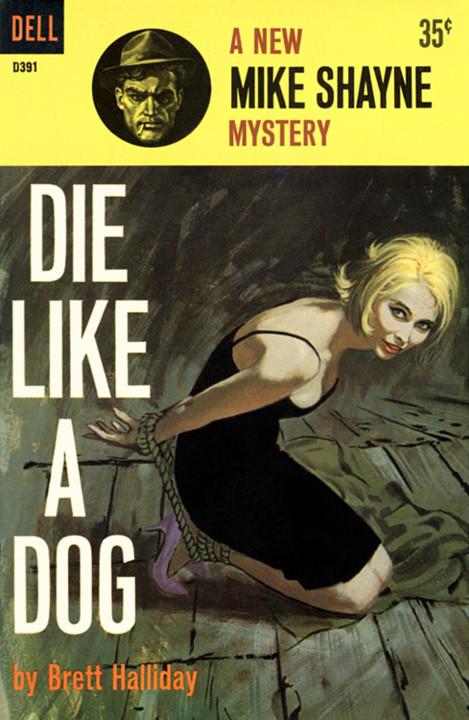oleebook.com
A Fine Tops'l Breeze - War of 1812 02 de William H White
de William H White - Género: English
Sinopsis
A Fine Tops'l Breeze - War of 1812 02
Series: War of 1812
By: William H. White
Cover Art: Paul Garnett
ISBN 10: 1888671408
ISBN 13: 9781500234041
ASIN: B006FM95GM
eISBN 10: 1500234044
eISBN 13: 9781500234041
Library of Congress Catalogue Card Number:
Publisher: Sea Fiction Press (2014)
Continuing the adventures of the newest character in American sea fiction, Isaac Biggs of Marble head, Massachusetts, this second volume of the trilogy finds Isaac as Third Mate on the Salem privateer General Washington in February 1813. At the same time, his friends from the British frigate Orpheus and the Baltimore schooner Glory find berths on the American warship USS Constellation and, eventually, they wind up on the USS Chesapeake in Boston just in time for her disastrous meeting with HMS Shannon.
Throughout the spring of 1813, Isaac and the General Washington roam the waters between Massachusetts and Nova Scotia, taking prizes and harassing the British. When the American survivors of the Chesapeake/Shannon battle are confined in Melville Island Prison in Halifax, the General Washington and Isaac play an important role in securing their freedom.
Libros Recomendados - Relacionados
Reseñas Varias sobre este libro
Im on a bit of a War of 1812 kick at the minute, mostly due to the fact that June 1 this year was the bicentenary of the battle between HMS Shannon and USS Chesapeake. This battle, and the people involved, fascinate me, and I really loved the fictionalised account of it in Patrick OBrians The Fortune of War. But although Ive been reading some excellent non-fiction on the subject, too, I was dying for some more novels with hawt Shannon/Chesapeake action. Which is how I found this book.
A Fine Topsl Breeze follows two separate plot threads. The first centres on Isaac Biggs, an American sailor who was once pressed into service in a British frigate, now third mate in American privateer the General Washington, as she cruises the New England coastline, harassing British shipping. The second storyline follows some of Biggs former shipmates, now aboard the Navy frigate USS Constellation. When the Constellation runs aground whilst running through a British blockade, they find themselves transferred to USS Chesapeake as she refits in Boston. When newly-famous captain James Lawrence takes command, he rushes his inexperienced crew out to sea to meet the blockading British frigate Shannon. As history inevitably runs its course and the Chesapeakes are imprisoned in Halifax, the two storylines converge as Biggs and the General Washingtons stage a daring rescue mission.
First, I should point out that this is the second in a trilogy, and I havent read the first one, because I just really needed a Shannon/Chesapeake fix! (Not obsessed, no sir!) So I totally own that rushing straight into book two without reading the first one mightve put me at a disadvantage, but in all honesty, I dont think it would have changed my opinion very much.
The best thing that the book has to recommend it is the nautical detail. As well as being a historian of the War of 1812, White is also a sailor himself, and the details of sailing and ship-handling all show that he knows his stuff. And as a historian of the period, he obviously understands the historical context of his novels setting, though he admits in his authors note that he has taken some historical licence for his story.
But despite Whites credentials as a historian and a sailor, his skills as a storyteller just dont pass muster. In fact, if it hadnt been for the promise of the Shannon/Chesapeake duel, I probably wouldve put it down after the first chapter. Although the nautical detail smacks of authenticity, the prose is workman at best, without any life or colour, and not once did I feel I was actually being drawn into the world of the story. The action scenes suffer for this, too. Parts of the Shannon/Chesapeake battle, for instance, read as if theyre from a textbook, rather than a dramatised retelling of a historical event:
The British captain had ordered grape and canister shot along with the ball, intending to win the day by decimating the crew rather than destroying the vessel. It told. The carnage was terrible; more than fifty men were killed immediately and over seventy were wounded.
This is just not evocative writing. Somehow I doubt that any Chesapeake standing on the deck would have been able to register the carnage around him in such precise numbers, or twig Brokes strategy in such clear terms as soon as the Shannon fired her broadside. Were being told about the grape-shot barrage, but were not experiencing it. This is how non-fiction is written, not novels. In fact, telling over showing is a constant issue in this story.
The structure of the book is also problematic. Were balancing our time between two separate storylines, and White has the habit of switching between the two of them just as one is building up to something eg. a cutting-out expedition or a fight. Now, I a good cliffhanger as much as anyone, but White overuses this device to the point where every switch causes the story to lose momentum, and actually makes the whole thing feel choppy, making me wish that hed just stick with a single episode and develop it. Pacing is also an issue. For instance, at one point were with Biggs until mid-July, then were shifted straight back to the Chesapeakes as theyre taken to Melville Island prison at the beginning of June. To be fair, he keeps the focus in one place during the Shannon/Chesapeake battle, and on the Melville Island raid, but most of the narrative leaps back and forward till its impossible to get engaged. The first few chapters are also stuffed with filler a flashback sequence that doesnt add anything to the story and there are a few times where he resorts to info-dumping historical background, such as the history of Melville Island, which all slow the pace.
But for me, the books crucial failing was characterisation. I never once got the sense of these men as individuals. With the exception of one mans vaguely-portrayed romantic troubles, these characters completely lack any individual lives. They have no background (in this book, at least), or any hopes, fears, and aspirations of their own. They have no character arcs, at all. These are just paper cut-outs being shuffled from one set-piece to the next. And most characters whether theyre American, English, or Irish speak in the exact same dialect, in the exact same voice, so theres no way of differentiating them that way.
In fact, its pretty telling that the characters are often referred to, in the prose itself, as Third Mate Biggs, Bosun Clements, or the Irishman, because thats about the only way to tell them apart. Dialogue is mostly expository, too, as the characters fill us in on whats been happening since we last saw them, or on the historical context around them. Very rarely do we ever see some proper conversations or banter: the things that really show us character. Minor characters suffer for this, too, to the point where, when I was picking up the book again, I found it hard to remember which minor character belonged to which ship, because they were so interchangeable.
This even applies to the historical characters. James Lawrence, when he makes his obligatory appearance, is pure cardboard. I may be in danger here of criticising a book for something it wasnt meant to be in the first place, as its obvious that White wants to let his readers see the world from the point of view of the ordinary sailors, rather than the officers. But one of the reasons I historical fiction is that it gives us a chance to explore different interpretations of people and/or events. Considering that to this day, Lawrences motives for engaging the Shannon, and his actions during the battle, are still subject to debate, putting fictional characters on the Chesapeake would be an ideal way to observe him and take a stab at interpreting his thoughts and actions. Its clear from the authors note that White has opinions about Lawrence (though, for what its worth, I feel his assessment is unnecessarily harsh), but in his story, he makes very little attempt to interpret Lawrence at all. Lawrence takes command, attempts to fix the Chesapeake into something a fighting ship, sails out to meet the Shannon, loses and dies, and the reader is left none the wiser as to why any of this happens.
The only character who engaged my interest at all was a secondary character, Midshipman (later Lieutenant) Blanchard, for the precise reason that hes the only one who shows any sort of development arc, going from a green rookie to a confident young officer. Okay, most of this development happens offstage, and were simply told that hes grown in confidence, but its more than even the main characters get. We first see him as a nervous, seasick youngster on his first command in a schooner, then we see him come up with a daring ruse to throw off the attentions of a British ship, then we see him as one of the only officers on the Chesapeake trying to keep order before Lawrence arrives. Its not brilliant, but there was enough of a spark there to have me thinking that this book was suffering from Misplaced Protagonist Syndrome. Stop the bus, I wanna read about him!
Historically, the book is pretty sound, though Ive already hinted that I dont really agree with Whites assessment of James Lawrence, but since very little of said assessment actually makes it into the book, its kind of a moot point. I would definitely disagree that the Chesapeake's crew were hopelessly unready for sea, though. Im no expert, but from what Ive read, the crew, including the newcomers, were more experienced and capable than given credit for here. Far from the outcome of the battle being pre-ordained, as White has it, Ive seen several compelling arguments (most recently in Lambert) that if some minute details had been different, it might have been an even more close-run thing. After all, didnt Nelson himself say that nothing is sure in a sea-fight above all?
Another curious thing is Whites characterisation of the New Englanders as pro-British. I know that New England was generally opposed to the war, but at the same time, I dont get the impression that there were many of them going around waving Union Jacks and singing Rule Britannia. I guess there must have been individuals, or even communities, who did have British sympathies, but it just seemed really odd that White would immediately equate being anti-war with being pro-British.
As for the historical licence that Whites takes the raid on Melville Island to free the surviving Chesapeakes well, historical accuracy in historical fiction is really in the eye of the beholder. I tend to fall on the side that prefers the story to fit the history, rather than the other way around. So in this case, the invented jailbreak that happens in lieu of real events (historically, the Chesapeakes were repatriated a few months after the battle), didnt really work for me. But thats a matter of taste more than anything.
So, all in all, I couldnt recommend this book. Seeing the Age of Sail from a point of view other than the British navy is a nice change of pace, but between the poor characterisation and mediocre writing, this one was a real disappointment.age-of-sail fiction historical-fiction ...more An EyeYii3,633 62
Autor del comentario:
=================================












